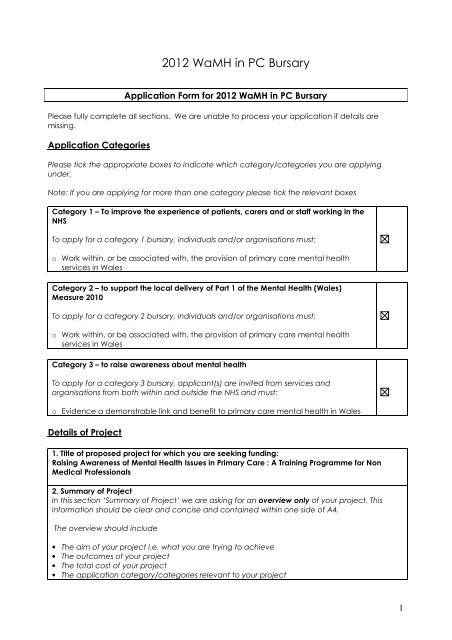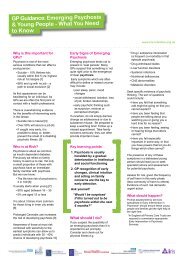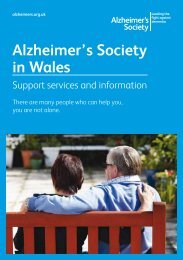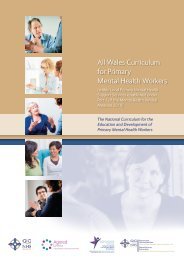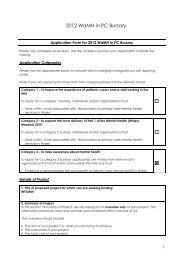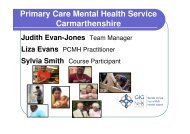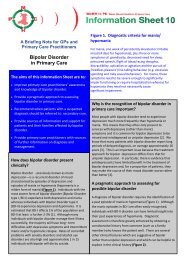Raising Awareness of Mental Health Issues in Primary Care
Raising Awareness of Mental Health Issues in Primary Care
Raising Awareness of Mental Health Issues in Primary Care
You also want an ePaper? Increase the reach of your titles
YUMPU automatically turns print PDFs into web optimized ePapers that Google loves.
2012 WaMH <strong>in</strong> PC Bursary<br />
Application Form for 2012 WaMH <strong>in</strong> PC Bursary<br />
Please fully complete all sections. We are unable to process your application if details are<br />
miss<strong>in</strong>g.<br />
Application Categories<br />
Please tick the appropriate boxes to <strong>in</strong>dicate which category/categories you are apply<strong>in</strong>g<br />
under.<br />
Note: If you are apply<strong>in</strong>g for more than one category please tick the relevant boxes<br />
Category 1 – To improve the experience <strong>of</strong> patients, carers and or staff work<strong>in</strong>g <strong>in</strong> the<br />
NHS<br />
To apply for a category 1 bursary, <strong>in</strong>dividuals and/or organisations must:<br />
o Work with<strong>in</strong>, or be associated with, the provision <strong>of</strong> primary care mental health<br />
services <strong>in</strong> Wales<br />
Category 2 – to support the local delivery <strong>of</strong> Part 1 <strong>of</strong> the <strong>Mental</strong> <strong>Health</strong> (Wales)<br />
Measure 2010<br />
To apply for a category 2 bursary, <strong>in</strong>dividuals and/or organisations must:<br />
o Work with<strong>in</strong>, or be associated with, the provision <strong>of</strong> primary care mental health<br />
services <strong>in</strong> Wales<br />
Category 3 – to raise awareness about mental health<br />
To apply for a category 3 bursary, applicant(s) are <strong>in</strong>vited from services and<br />
organisations from both with<strong>in</strong> and outside the NHS and must:<br />
o Evidence a demonstrable l<strong>in</strong>k and benefit to primary care mental health <strong>in</strong> Wales<br />
Details <strong>of</strong> Project<br />
1. Title <strong>of</strong> proposed project for which you are seek<strong>in</strong>g fund<strong>in</strong>g:<br />
<strong>Rais<strong>in</strong>g</strong> <strong>Awareness</strong> <strong>of</strong> <strong>Mental</strong> <strong>Health</strong> <strong>Issues</strong> <strong>in</strong> <strong>Primary</strong> <strong>Care</strong> : A Tra<strong>in</strong><strong>in</strong>g Programme for Non<br />
Medical Pr<strong>of</strong>essionals<br />
2. Summary <strong>of</strong> Project<br />
In this section ‘Summary <strong>of</strong> Project’ we are ask<strong>in</strong>g for an overview only <strong>of</strong> your project. This<br />
<strong>in</strong>formation should be clear and concise and conta<strong>in</strong>ed with<strong>in</strong> one side <strong>of</strong> A4.<br />
The overview should <strong>in</strong>clude<br />
• The aim <strong>of</strong> your project i.e. what you are try<strong>in</strong>g to achieve<br />
• The outcomes <strong>of</strong> your project<br />
• The total cost <strong>of</strong> your project<br />
• The application category/categories relevant to your project<br />
1
• Evidence <strong>of</strong> the three hallmarks <strong>of</strong> positive relationships<br />
Aim<br />
The aim <strong>of</strong> this project is to deliver mental health awareness tra<strong>in</strong><strong>in</strong>g to receptionists and nonhealthcare<br />
staff who have patient contact with<strong>in</strong> primary care. This tra<strong>in</strong><strong>in</strong>g programme will<br />
provide staff with <strong>in</strong>formation on how mental health problems <strong>in</strong>fluence a patient’s daily life<br />
and activities, and how these problems can subsequently affect their <strong>in</strong>teraction with primary<br />
care. Therefore, as a direct result <strong>of</strong> this tra<strong>in</strong><strong>in</strong>g, staff will have a raised awareness <strong>of</strong> mental<br />
health problems and will be able to <strong>in</strong>teract more effectively with patients suffer<strong>in</strong>g with mental<br />
health problems.<br />
Outcomes<br />
In order to evaluate the success <strong>of</strong> the tra<strong>in</strong><strong>in</strong>g programme, a patient satisfaction questionaire<br />
will be developed and adm<strong>in</strong>istered pre- and post- tra<strong>in</strong><strong>in</strong>g. For the receptionists, a<br />
questionaire <strong>in</strong>vestigat<strong>in</strong>g staff attitudes towards mental health and service provision will be<br />
adm<strong>in</strong>istered. Measures will be collected pre- and post- tra<strong>in</strong><strong>in</strong>g, <strong>in</strong> addition to at a six month<br />
follow-up. This is to <strong>in</strong>vestigate whether the tra<strong>in</strong><strong>in</strong>g has long last<strong>in</strong>g effects regard<strong>in</strong>g the way<br />
that staff <strong>in</strong>teract with patients.<br />
The potential benefits <strong>of</strong> deliver<strong>in</strong>g this tra<strong>in</strong><strong>in</strong>g programme are plentiful and will affect not only<br />
the patient, but also their family and both primary and secondary healthcare services.<br />
Its is hoped that as a result <strong>of</strong> receptionists becom<strong>in</strong>g more <strong>in</strong>formed and therefore more<br />
accommodat<strong>in</strong>g towards those with mental health problems, there will be a reduction <strong>of</strong> nonattendance<br />
<strong>of</strong> appo<strong>in</strong>tments, a reduction <strong>in</strong> anxiety surround<strong>in</strong>g attend<strong>in</strong>g an appo<strong>in</strong>tment<br />
and a reduction <strong>in</strong> the level <strong>of</strong> perceived stigma experienced by the patient. Furthermore, it<br />
could be anticipated that these benefits would ensure that a relationship between the patient<br />
and the service is developed and ma<strong>in</strong>ta<strong>in</strong>ed, thus ensur<strong>in</strong>g the effective service provision.<br />
Furthermore, as the patient may be <strong>in</strong> more regular contact with primary care as a result <strong>of</strong><br />
reduced anxiety and perceived stigma, relapse rates could be reduced and any additional<br />
problems would be identified early, thus lead<strong>in</strong>g to a reduction <strong>of</strong> referrals <strong>in</strong>to secondary care<br />
and the reduced <strong>in</strong>volvement <strong>of</strong> crisis teams.<br />
Information regard<strong>in</strong>g this tra<strong>in</strong><strong>in</strong>g package will be sent to GP practices and <strong>Primary</strong> <strong>Care</strong><br />
Centres throughout the ABMU health board. Staff will be <strong>in</strong>vited to the course, which will be<br />
held at convenient times and at a location with<strong>in</strong> close proximity to ensure maximum<br />
attendance.<br />
Cost<br />
In order to develop and deliver the awareness tra<strong>in</strong><strong>in</strong>g, £3,000 is required. This will ensure<br />
sufficient time to source and develop resources, host the programme <strong>in</strong> sett<strong>in</strong>gs outside the<br />
health service and promote the tra<strong>in</strong><strong>in</strong>g to the eligible staff.<br />
Relevant Application Categories<br />
Category 1: To improve the experience <strong>of</strong> patients, carers and/or staff work<strong>in</strong>g <strong>in</strong> the NHS.<br />
The current project directly meets this category as it seeks to improve patient experience <strong>in</strong><br />
primary care by <strong>in</strong>creas<strong>in</strong>g the awareness <strong>of</strong> primary care receptionists. It is hoped that as a<br />
result, the experience <strong>of</strong> contact<strong>in</strong>g and attend<strong>in</strong>g primary care sett<strong>in</strong>gs will be less anxiety<br />
provok<strong>in</strong>g and result <strong>in</strong> the development and ma<strong>in</strong>tenance <strong>of</strong> <strong>in</strong>teractions between the<br />
<strong>in</strong>dividual and the service. This will hopefully lead to a reduction <strong>in</strong> the risk <strong>of</strong> relapse or the<br />
development <strong>of</strong> other problems, such as medication non-adherence. This will <strong>in</strong> turn benefit<br />
2
the sufferer’s family as relapse is also a traumatic and stressful experience for carers.<br />
Furthermore, this project will also benefit secondary care as an improved service at primary<br />
care level will lead to the reduction <strong>in</strong> referrals to secondary care and crisis teams.<br />
Category 2: To support the local delivery <strong>of</strong> Part 1 <strong>of</strong> the <strong>Mental</strong> <strong>Health</strong> (Wales) Measure 2010.<br />
This project aims to improve mental health service provision <strong>in</strong> <strong>Primary</strong> care, directly meet<strong>in</strong>g<br />
the Category 2 objective.<br />
Category 3: To raise awareness about mental health.<br />
In recent years, mental health issues have become more widely accepted <strong>in</strong> society. Despite<br />
this, a stigma still surrounds mental health service users and the mental health services<br />
available. This <strong>in</strong> turn creates a barrier to access<strong>in</strong>g services and as a result, <strong>in</strong>dividuals do not<br />
seek the help which would address and reduce their problems. This project would directly<br />
address this category as it seeks to improve awareneses <strong>of</strong> mental health and service provision<br />
with<strong>in</strong> primary care. By tra<strong>in</strong><strong>in</strong>g frontl<strong>in</strong>e primary care staff and <strong>in</strong>creas<strong>in</strong>g their awareness <strong>of</strong><br />
mental health problems, it is hoped that staff will provide a service tailored to the patient’s<br />
needs. This would result <strong>in</strong> decreased stigma and ensure that the patient feels able to make<br />
future contact with the service.<br />
Evidence <strong>of</strong> the Three Hallmarks <strong>of</strong> Positive Relationships<br />
Ma<strong>in</strong>ta<strong>in</strong><strong>in</strong>g Trust - Develop<strong>in</strong>g and deliver<strong>in</strong>g a tra<strong>in</strong><strong>in</strong>g package to raise awareness<br />
demonstrates the service’s commitment to improv<strong>in</strong>g staff competence. This <strong>in</strong> turn enables<br />
the team to work <strong>in</strong> a open and honest manner with patients <strong>in</strong> order to provide a more<br />
effecitve service.<br />
Good Communication -Tra<strong>in</strong><strong>in</strong>g will enhance awareness <strong>of</strong> mental health problems as a result<br />
will <strong>in</strong>fluence the staff’s approach when liais<strong>in</strong>g with service users. As awareness becomes<br />
raised, the effectiveness <strong>of</strong> communication will <strong>in</strong>crease as staff will have an improved<br />
understand<strong>in</strong>g <strong>of</strong> patient’s needs and difficulties. Furthermore, this tra<strong>in</strong><strong>in</strong>g will also illustrate<br />
that the views <strong>of</strong> serivce users are be<strong>in</strong>g listened to by the trust, and demonstrate the effort<br />
made on behalf <strong>of</strong> the trust <strong>in</strong> order to improve the experience <strong>of</strong> primary care for service<br />
users.<br />
Shared Values <strong>of</strong> Person-Centredness - The above two po<strong>in</strong>ts demonstrate our commitment to<br />
develop<strong>in</strong>g services based on what the <strong>in</strong>dvidual wants and needs. By provid<strong>in</strong>g this tra<strong>in</strong><strong>in</strong>g<br />
to receptionsts and non-medical staff <strong>in</strong> primary care, we are also shar<strong>in</strong>g knowledge and<br />
expertise, ensur<strong>in</strong>g that responsibility for the patient care is dispersed from front l<strong>in</strong>e staff <strong>in</strong><br />
primary care sett<strong>in</strong>gs through to staff manag<strong>in</strong>g more complex cases <strong>in</strong> secondary care, and<br />
beyond.<br />
3. Background to the proposed project:<br />
Applicants are required to detail, <strong>in</strong> this section:<br />
Why there is a need for your project?<br />
What evidence/research do you have which supports the need for this project to be<br />
implemented?<br />
What exist<strong>in</strong>g services / strategies have <strong>in</strong>formed the development <strong>of</strong> your project?<br />
How will your project l<strong>in</strong>k <strong>in</strong>to and support/enhance new/exist<strong>in</strong>g services/strategies?<br />
What benefits will be achieved through the implementation <strong>of</strong> this project?<br />
<strong>Mental</strong> health problems such as depression are most <strong>of</strong>ten managed <strong>in</strong> primary care (L<strong>in</strong> et al.,<br />
2008). Therefore, <strong>in</strong> order to manage mental health conditions successfully, effective<br />
<strong>in</strong>teraction between patients and healthcare pr<strong>of</strong>essionals <strong>in</strong> primary care is key. Despite this,<br />
D<strong>in</strong>os (2004) reports that <strong>in</strong>dividuals suffer<strong>in</strong>g with mental health problems <strong>of</strong>ten feel stigmatised<br />
and as a result, are less likely to contact mental health services. This <strong>in</strong> turn, may result <strong>in</strong><br />
medication non-adherence (Sirey et al., 2001). In order to secure contact with a GP, patients<br />
3
need to <strong>in</strong>teract with non-medical staff, such as receptionists and adm<strong>in</strong>istrative staff. If<br />
receptionists are unaware <strong>of</strong> the effects that mental health problems can have on activities <strong>of</strong><br />
daily liv<strong>in</strong>g, this may <strong>in</strong>fluence the communication and <strong>in</strong>teraction when work<strong>in</strong>g with mental<br />
health patients. For example, if receptionists are not aware that patients with a range <strong>of</strong> mental<br />
health problems may have difficulty gett<strong>in</strong>g up <strong>in</strong> the morn<strong>in</strong>g, they may <strong>of</strong>fer the patient an<br />
early appo<strong>in</strong>tment. The patient may subsequently not attend his appo<strong>in</strong>tment, as a result <strong>of</strong> this<br />
difficulty. Tra<strong>in</strong><strong>in</strong>g would give receptionists sufficient knowledge to enable them to <strong>of</strong>fer such<br />
patients a more suitable appo<strong>in</strong>tment, thereby <strong>in</strong>creas<strong>in</strong>g the chances <strong>of</strong> attendance and<br />
effective service provision.<br />
However, tra<strong>in</strong><strong>in</strong>g for receptionists <strong>in</strong> mental health areas is rare, although it has been shown to<br />
be effective (White et al., 2008). Therefore, this approach would not only be beneficial for<br />
patients, but also the staff and the healthcare service as a whole, as it would <strong>in</strong>crease staff<br />
morale and acknowledge their role as an <strong>in</strong>tegral part <strong>of</strong> the service (Pyke and Butterill, 2001).<br />
Furthermore, this project would reduce stigma and encourage mental health patients to<br />
engage <strong>in</strong> primary care services. Additionally, it would lead to a reduction <strong>in</strong> referrals to<br />
secondary care and reduce the levels <strong>of</strong> stress and anxiety that can by experienced by the<br />
families <strong>of</strong> such patients.<br />
4. Purpose <strong>of</strong> the proposed project:<br />
Applicants are required to detail, <strong>in</strong> this section:<br />
The methods you would use to develop their project<br />
Evidence <strong>of</strong> the three hallmarks <strong>of</strong> positive relationships:<br />
• Trust – demonstration <strong>of</strong> honesty, competence and openness<br />
• Good Communication – a mean<strong>in</strong>gful <strong>in</strong>teraction between liv<strong>in</strong>g be<strong>in</strong>gs.<br />
• Person Centredness – see<strong>in</strong>g the client/ practitioner as a person, shar<strong>in</strong>g power and<br />
responsibility<br />
Evidence <strong>of</strong> the Three Hallmarks <strong>of</strong> Positive Relationships<br />
Ma<strong>in</strong>ta<strong>in</strong><strong>in</strong>g Trust - Develop<strong>in</strong>g and deliver<strong>in</strong>g a tra<strong>in</strong><strong>in</strong>g package to raise awareness<br />
demonstrates the service’s commitment to improv<strong>in</strong>g staff competence. This <strong>in</strong> turn enables<br />
the team to work <strong>in</strong> a open and honest manner with patients <strong>in</strong> order to provide a more<br />
effecitve service.<br />
Good Communication ¬– Tra<strong>in</strong><strong>in</strong>g will enhance awareness <strong>of</strong> mental health problems as a<br />
result will <strong>in</strong>fluence the staff’s approach when liais<strong>in</strong>g with service users. As awareness<br />
becomes raised, the effectiveness <strong>of</strong> communication will <strong>in</strong>crease as staff will have an<br />
improved understand<strong>in</strong>g <strong>of</strong> patient’s needs and difficulties. Furthermore, this tra<strong>in</strong><strong>in</strong>g will also<br />
illustrate that the views <strong>of</strong> serivce users are be<strong>in</strong>g listened to by the trust, and demonstrate the<br />
effort made on behalf <strong>of</strong> the trust <strong>in</strong> order to improve the experience <strong>of</strong> primary care for service<br />
users.<br />
Shared Values <strong>of</strong> Person-Centredness - The above two po<strong>in</strong>ts demonstrate our commitment to<br />
develop<strong>in</strong>g services based on what the <strong>in</strong>dvidual wants and needs. By provid<strong>in</strong>g this tra<strong>in</strong><strong>in</strong>g<br />
to receptionsts and non-medical staff <strong>in</strong> primary care, we are also shar<strong>in</strong>g knowledge and<br />
expertise, ensur<strong>in</strong>g that responsibility for the patient care is dispersed from front l<strong>in</strong>e staff <strong>in</strong><br />
primary care sett<strong>in</strong>gs through to staff manag<strong>in</strong>g more complex cases <strong>in</strong> secondary care, and<br />
beyond.<br />
5. Planned Outcomes for dissem<strong>in</strong>ation, susta<strong>in</strong>ability and evaluation<br />
How will you evaluate the success <strong>of</strong> the project?<br />
What are the ma<strong>in</strong> outcomes and successes?<br />
How have you actively raised awareness <strong>of</strong> your project?<br />
Outcomes<br />
4
In order to evaluate the success <strong>of</strong> the tra<strong>in</strong><strong>in</strong>g programme, a patient satisfaction questionaire<br />
will be developed and adm<strong>in</strong>istered pre- and post- tra<strong>in</strong><strong>in</strong>g. For the receptionists, a<br />
questionaire <strong>in</strong>vestigat<strong>in</strong>g staff attitudes towards mental health and service provision will be<br />
adm<strong>in</strong>istered. Measures will be collected pre- and post- tra<strong>in</strong><strong>in</strong>g, <strong>in</strong> addition to at a six month<br />
follow-up. This is to <strong>in</strong>vestigate whether the tra<strong>in</strong><strong>in</strong>g has long last<strong>in</strong>g effects regard<strong>in</strong>g the way<br />
that staff <strong>in</strong>teract with patients.<br />
The potential benefits <strong>of</strong> deliver<strong>in</strong>g this tra<strong>in</strong><strong>in</strong>g programme are plentiful and will affect not only<br />
the patient, but also their family and both primary and secondary healthcare services.<br />
Its is hoped that as a result <strong>of</strong> receptionists becom<strong>in</strong>g more <strong>in</strong>formed and therefore more<br />
accommodat<strong>in</strong>g towards those with mental health problems, there will be a reduction <strong>of</strong> nonattendance<br />
<strong>of</strong> appo<strong>in</strong>tments, a reduction <strong>in</strong> anxiety surround<strong>in</strong>g attend<strong>in</strong>g an appo<strong>in</strong>tment and<br />
a reduction <strong>in</strong> the level <strong>of</strong> perceived stigma experienced by the patient. Furthermore, it could<br />
be anticipated that these benefits would ensure that a relationship between the patient and the<br />
service is developed and ma<strong>in</strong>ta<strong>in</strong>ed, thus ensur<strong>in</strong>g the effective service provision.<br />
Furthermore, as the patient may be <strong>in</strong> more regular contact with primary care as a result <strong>of</strong><br />
reduced anxiety and perceived stigma, relapse rates could be reduced and any additional<br />
problems would be identified early, thus lead<strong>in</strong>g to a reduction <strong>of</strong> referrals <strong>in</strong>to secondary care<br />
and the reduced <strong>in</strong>volvement <strong>of</strong> crisis teams.<br />
Information regard<strong>in</strong>g this tra<strong>in</strong><strong>in</strong>g package will be sent to GP practices and <strong>Primary</strong> <strong>Care</strong><br />
Centres throughout the ABMU health board. Staff will be <strong>in</strong>vited to the course, which will be held<br />
at convenient times and at a location with<strong>in</strong> close proximity to ensure maximum attendance.<br />
6. Support<strong>in</strong>g Evidence / References<br />
D<strong>in</strong>os, S., Stevens, S., Serfaty, M., Welch, S. and K<strong>in</strong>g, M. (2004) Stigma: the feel<strong>in</strong>gs and<br />
experiences <strong>of</strong> 46 people with mental illness Qualitative study The British Journal <strong>of</strong> Psychiatry,<br />
184: 176-181<br />
L<strong>in</strong>, E. H. B., Katon, W. J., VonKorff, M., Russo, J. E., Simon, G. E., Bush, T. M., Rutter, C. M., Walker,<br />
E. A., & Ludman, E. (1998). Relapse <strong>of</strong> Depression <strong>in</strong> <strong>Primary</strong> <strong>Care</strong>: Rate and Cl<strong>in</strong>ical Predictors.<br />
Family Medic<strong>in</strong>e, 7, 443-449.<br />
Pyke J and Butterill D (2001) A workshop for receptionists <strong>in</strong> mental health sett<strong>in</strong>gs. Psychiatric<br />
Rehabilitation Journal 24(4): 401–4<br />
Sirey, J.A., Bruce, M.L., Alexopoulos, G.S., Perlick, D.E., Friedman, S.E., Barnett S., and Meyers, S<br />
(2001) Stigma as a Barrier to Recovery: Perceived Stigma and Patient-Rated Severity <strong>of</strong> Illness<br />
as Predictors <strong>of</strong> Antidepressant Drug Adherence Psychiatric Services 52:1615-1620.<br />
White, C., Riley, A. and Smith, S. (2008) <strong>Awareness</strong> <strong>of</strong> depression at the reception desk:<br />
education for primary care receptionists Education for <strong>Primary</strong> <strong>Care</strong> : 173–90<br />
7. Commencement Date: March 2012<br />
8. Completion Date: September 2012<br />
5


